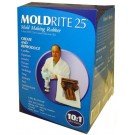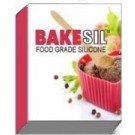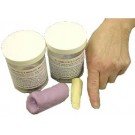Silicone mold making material is often the best choice for creating a variety molds types. The mold rubber consists of a two-part RTV material. Room temperature Vulcanization materials are frequently referred to in mold making materials as RTV. This class of silicone rubbers cure at room temperature, without the need for added heat as other materials might. Even so, the higher the ambient temperature, the faster RTV silicone rubbers will cure.
RTV silicone rubbers are divided into two families; poly-condensation or tin-cure and poly-addition or platinum-cure. The chemical catalyst that causes the mold rubber to change from a liquid to a solid contains tin in the former and platinum in the latter, as the names imply. Of the two, the platinum-cure is the most expensive to purchase due to the precious metal that it contains. But the platinum silicone offers better mold stability, longer life and less shrinkage.
For every pro there is usually a con, and in this case, the addition-cure rubber is especially sensitive to inhibition from a wide variety of materials such as sulfur that is often found in certain modeling clays. Thus, the base (Part A) and the catalyst (Part B) must be combined very precisely to produce a good cure. On the other hand, condensation-cure rubber is less expensive (after all it is tin compared to platinum), has almost a trouble-free curing, and is not sensitive to inhibition as is its higher priced cousin.
Unlike the silicone caulking found in home improvement stores, condensation-cure and addition-cure silicone rubbers are two-part systems consisting of a base and a catalyst. Condensation-cure silicone rubber yields accurate, chemical resistant molds for casting resin, foam, plaster, and wax. These tin-cure silicone rubbers are the easiest to work with are not easily inhibited by contamination. Tin-cure silicone rubbers often have mix-ratios other than the one-to-one mix ratios found in addition-cure rubbers. Thus, they require an accurate gram scale for mixing exact amounts by volume.
Tin-catalyzed mold rubbers such as MoldRite 25 make economical production molds and are often a good choice for mold makers, or as with SkinRite 10, to prosthetics and doll making,but at the expense its shorter storage life (known as library life) than platinum-cure mold rubbers That is because as condensation-cure rubbers age, they lose elasticity, become brittle and the surface tends to pill. Modern addition-cure formulated silicone rubbers offer longer library life, but, foundries may require twenty-five years or more, which condensation-cure rubbers could not possibly meet. So if a longer library life is required then there are just two choices, polyurethane rubber systems and platinum-cured silicone mold rubbers.
Platinum-catalyzed silicone rubbers such as LifeRite and 5-Minute Mold Putty, offer other advantages besides extended archival life. An important consideration is that they will cure with virtually no shrinkage to a durable, long-lasting, chemical resistant rubber. The sizing accuracy advantage alone often far outweighs the added cost of the product, making it the popular choice of the prototyping industry. In prototyping, detail is an issue and platinum-cure silicone rubbers deliver. For resin casting, foam casting, and archived molds for foundry patterns, addition-cure rubber is the best choice if budget permits. However, special care must be taken when using a platinum silicone rubber as it is easy to contaminate which will prevent the rubber from curing leaving a viscous sticky mess on your pattern.
Since platinum-catalyzed silicone is recommended for a number of applications, a special attention needs to be made to its sensitivity to contamination. Cause for silicone inhibition includes not properly measuring out the specified mix ratio or not, thoroughly mixing the base and the catalyst together. Also addition-cure silicone is temperature sensitive, so using the platinum-cure silicone in an environment that is too cold may also lead to inhibition.
Contaminants such as sulfur and wax will cause inhibition. For example, if you are using oil-based clay and the clay contains sulfur (oil contains sulfur), the sulfur in the clay will cause an improper cure when the silicone comes in contact with it. Also, many waxes are petroleum-based, thus may contain sulfur. Even simple latex gloves can also cause inhibition as latex contains sulfur. Thus, you should use only non-sulfur-based clay and gloves other than latex.
RTV silicone are excellent choices for any mold maker. One big advantage, as unlike other mold rubbers, silicone rubbers often don't require a mold release, though using one will prolong the life of the mold. Knowing the differences between the two families of silicone rubbers and how to apply them will make you a much better mold maker and will enable you to make the right choice of the available silicone mold rubbers in the market place.
Happy mold making!
| Differences Between Condesation Cure and Addition Cure Silicone | ||
| Catalyst | Platinum | Tin |
| Shelf Life | 12-18-months | 12-18-months |
| Library Life | Up to 25 years | 5-7 years |
| Mix Ratio | 1-to-1 | 10-to-1 or some fraction |
| Set Times | Varies between formulas | Varies between formulas |
| Mold Release | None required | None required |
| Shrinkage | Very little to none | Some |
| Detail | Higest detail | Good detail |
| Inhibation | Very high - sensistive | Very low |
| Economics | Higher priced | Lower priced |
| Products | LifeRite; BakeSil; 5-Minute Mold Putty | MoldRite-25; SkinRite-10 |







